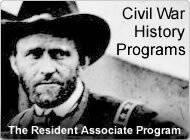
The All-American Christmas - isn't
The Smithsonian Associates Civil War E-Mail Newsletter, Volume 7, Number 3
Many of the traditions associated with Christmas celebrations in the United States today are related to the Civil War experience. By re-establishing familiar European traditions and creating some new ones, citizens and soldiers alike found solace from the loneliness, insecurities, and heartbreak of war. This created the illusion of love and peace at a time when very little of that existed in their daily lives.
Christmas, like most social events, was widely celebrated in Europe with eating, drinking, and dancing. The Puritans, however, put an end to this indulgent behavior when they came to America. On their arrival, Christmas became a serious occasion, the purpose of which was to introspectively ponder sin and religious commitment.
It took almost 200 years for the country to move away from this Puritan ethic and enjoy the holidays once more. Louisiana was the first state to make Christmas a holiday in 1830, and many states soon followed. Congress did not make Christmas a federal holiday until 1870. The extensive religious revival of the mid-19th century combined with the hardships of the Civil War to instill the nation with a desire to unite, celebrate, and recognize the joys of the Christmas season.
For the United States, the widespread customs of Christmas cards, carols, special foods, and holding winter dances, all date to about the 1850s. It was a feature story in Godey's Ladys' Book, the Vogue of its day, which initiated the custom of Christmas decorating. The story was about Queen Victoria and Prince Albert's Christmas preparations, which included a Christmas tree. This originally was a German custom Prince Albert brought to England from his country of birth.
After that, Americans began to cut evergreens and take them into the home as seasonal decorations. The trees were tabletop size and usually were arranged with fruit, candles, other greenery and mistletoe, all supposed to bring good luck to the household. Union soldiers' letters mention decorating their camp Christmas trees with salt-pork and hard tack.
It was the development of the modern Santa Claus that embedded Christmas into the American way of life. In 1862, German immigrant Thomas Nast was working as a writer and artist at Harper's Weekly. When he was tasked to create a drawing to accompany Clement Clark Moore's 1821 poem, 'Twas the Night Before Christmas, he reached back to his Bavarian childhood and the result became our All-American Santa Claus. Nast depicted his Santa as a Union man(!) , and also as cherubic and pot-bellied, bringing gifts of Harper's to the soldiers. This made Nast the first to combine imagery (Santa Claus) and commercialism (selling Harper's) into the American marketplace.
The gifts Santa brought children during the Civil War always were home made. In those days, children were happy to receive just small hand-carved toys, cakes, oranges or apples. Many Southern diaries tell the story of Santa running the blockaded ports in Dixie to fill children's stockings with what little the parents could spare to make the day special for them. Even General Sherman's soldiers played Santa to impoverished Southern children by attaching tree-branch antlers to their horses and mules as they delivered food to the starving families in the war-ravaged southern countryside.
The most famous Christmas gift of the Civil War was sent by telegram from William Tecumseh Sherman to Abraham Lincoln on December 22, 1864: "I beg to present you as a Christmas gift, the city of Savannah, with 100 and 50 guns and plenty of ammunition, also about 25,000 bales of cotton." The gift, of course, was not the guns, the ammunition, or the cotton, but the beginning of the end of the Civil War.

